
Above photo: Adult Eastern Tiger Swallowtails require nectar plants, such as joe-pye-weed, but their larvae develop on trees, including black cherry and tulip tree; photo by Jason Ryndock (PNHP).
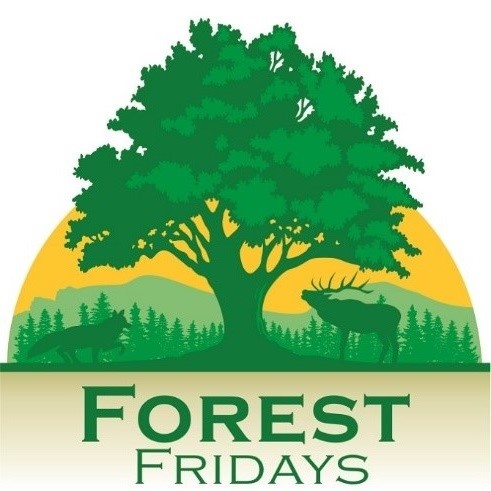
Written by Jason Ryndock, Ecological Information Specialist with the Pennsylvania Natural Heritage Program through the PA Department of Conservation and Natural Resources, as featured in the Bureau of Forestry‘s “Forest Fridays”.
When designing a butterfly garden, most people wouldn’t think to plant a tree. Yet approximately 30% of Pennsylvania’s 156 butterfly species use trees as host plants. Dr. Doug Tallamy of the University of Delaware found that relatively few keystone plant genera support the majority of butterfly and moth species…and many of these genera are trees or shrubs. Oaks are the superstars, supporting over 500 Lepidoptera species, with cherries, willows, birches, and poplars not far behind.
These keystone trees are caterpillar factories, churning out high insect biomass that is crucial for other wildlife, particularly birds. Nearly all terrestrial birds rear their young on arthropods (especially caterpillars and spiders) and many birds continue to feed on arthropods as adults. Even in the dead of winter, arthropods (including overwintering caterpillars) make up 50% of a black-capped chickadee’s diet and nearly 100% of a golden-crowned kinglet’s diet.
The best way to support wildlife is through native plants. Insect herbivores are often specialized feeders. Having coevolved with native plant communities, they are far less likely to feed on non-native plants. Below are some of the butterflies that might be attracted to a garden that includes native trees and shrubs.
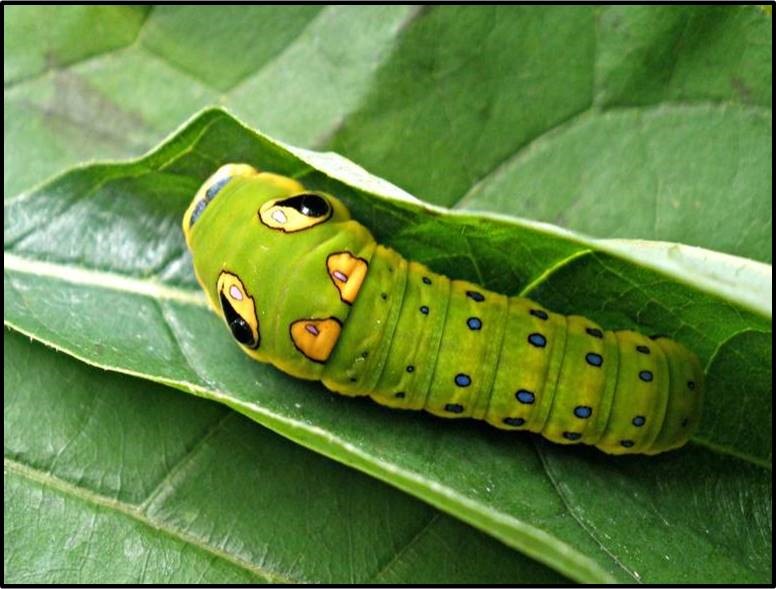
The Spicebush Swallowtail caterpillar appears to be a snake mimic, a defense perhaps most effective against Neotropical migratory birds; photo by Ansel Oommen, Bugwood.org.
Swallowtails (Papilionidae): Our three species of Tiger Swallowtail are hosted by a variety of trees, with black cherry common among them. Giant Swallowtail caterpillars mimic bird droppings splashed on the leaves of prickly-ash and hoptree, while Spicebush Swallowtail caterpillars, with fearsome eyespots, hide in folded leaves of sassafras and spicebush. The Zebra Swallowtail, perhaps our most striking species, is a specialist on pawpaw.
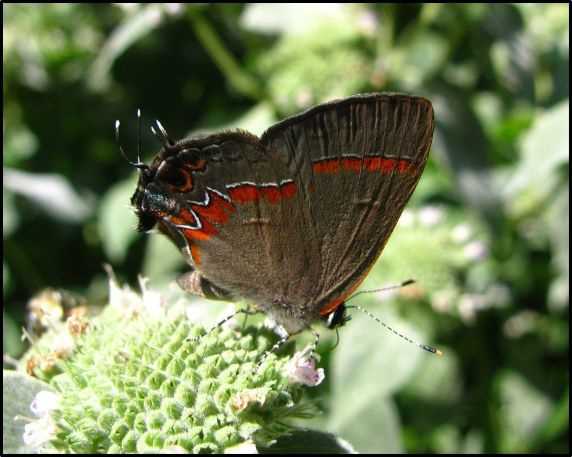
This Red-banded Hairstreak has graduated from a diet of dead leaves to a more respectable one of showy mountain-mint nectar…its false head is a decoy for jumping spiders; photo by Jason Ryndock (PNHP).
Gossamer Wings (Lycaenidae): The Oak Hairstreak is an elusive canopy dweller that develops on the catkins and young leaves of oaks. The acrophobic Red-banded Hairstreak not only flies close to the ground…its larvae prefer decaying leaves, particularly under sumacs. Conifer connoisseurs include the Eastern Pine Elfin, which feeds on white pine, pitch pine, and Virginia pine, as well as the gorgeous green Juniper Hairstreak, which prefers eastern red cedar.
Caterpillars of the Harvester, our only carnivorous butterfly, feed on wooly aphids infesting alders, American beech, and other woody plants.
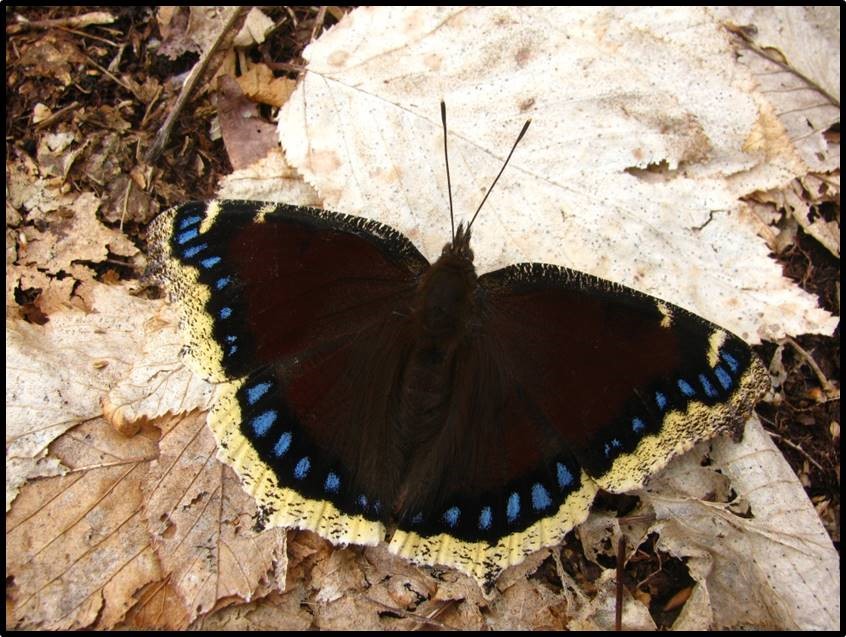
The Mourning Cloak is one of the first butterflies to emerge from hibernation in late winter or early spring photo by Jason Ryndock (PNHP).
Brushfoots (Nymphalidae): Both the American Snout and Hackberry Emperor feed on common and dwarf hackberry, but only the Emperor is guaranteed to survive our winter. Each year, waves of migrant Snout butterflies arrive from the South to repopulate. If you are looking to add some punctuation to your garden, hackberries and elms may bring you the Question Mark or Eastern Comma.
Adults of the Mourning Cloak aestivate in summer AND hibernate in winter, but are the first to emerge in February or March. Their caterpillars feed on many broadleaf trees, including elms and willows. Willows also host the Viceroy, which mimics the Monarch (or is it the other way around?). Both are toxic, an example of mutual Müllerian co-mimicry.
Skippers (Hesperiidae): Many skippers use grasses and legumes as larval hosts, but the Sleepy Duskywing has evolved to feed on oaks (and perhaps American chestnut sprouts), while the Dreamy Duskywing feeds on gray birch and quaking aspen. The range expansion of black locust has benefited the Silver-spotted Skipper.
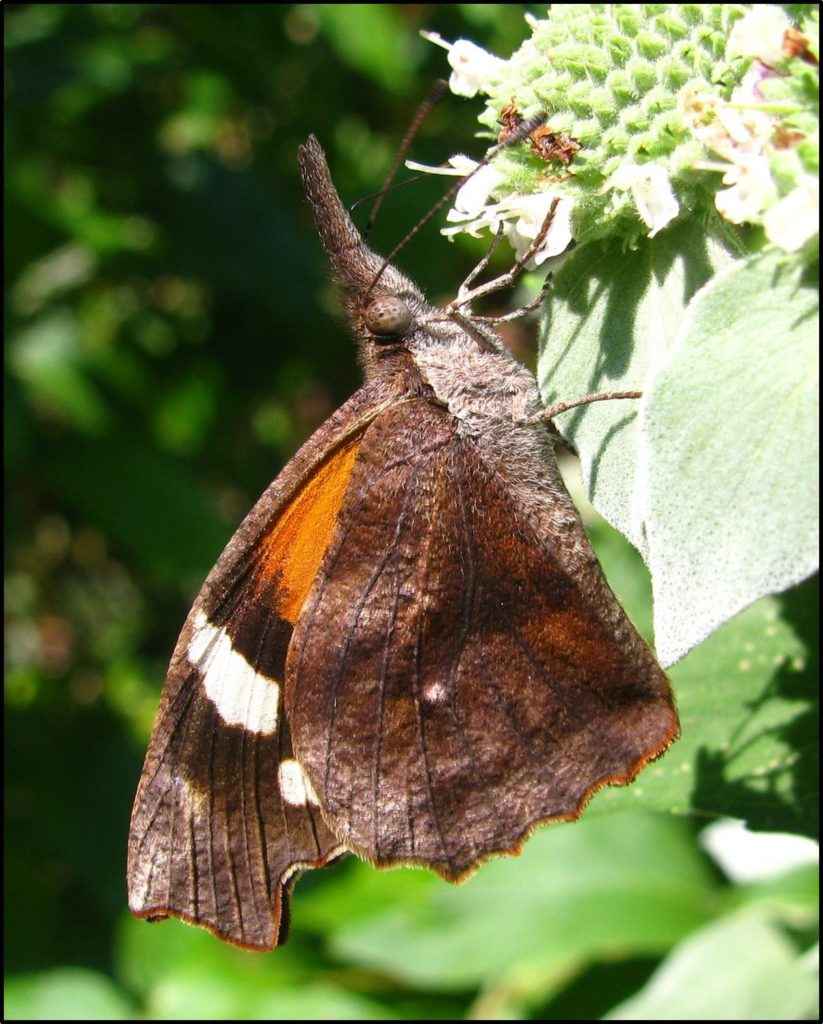
The offspring of this American Snout butterfly will not likely survive the Pennsylvania winter but may at least feed some birds; photo by Jason Ryndock (PNHP).




